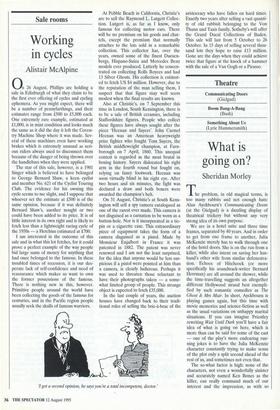Sale rooms
Working in cycles
Alistair McAlpine
On 26 August, Phillips are holding a sale in Edinburgh of what they claim to be the first ever offering of cycles and cycling ephemera. As you might expect, there will be a number of pennyfarthings, and their estimates range from £500 to £5,000 each. One extremely rare example, estimated at £1,000, is in mint condition and looks much the same as it did the day it left the Coven- try Machine Shop where it was made. Sev- eral of these machines even have working brakes which is extremely unusual as seri- ous riders always used to disconnect them because of the danger of being thrown over the handlebars when they were applied.
The star of this sale, however, is a 1901 Singer which is believed to have belonged to George Bernard Shaw, a keen cyclist and member No. 621 of the Cyclist Touring Club. The evidence for his owning this cycle seems to me slight, and I suppose that whoever set the estimate at £500 is of the same opinion, because if it was definitely Bernard Shaw's, another nought or two could have been added to its price. It is of little interest in its own right and is likely to fetch less than a lightweight racing cycle of the 1950s — a Hetchins estimated at £700.
I am interested in the outcome of this sale and in what this lot fetches, for it could prove a perfect example of the way people bid large sums of money for anything that had once belonged to the famous. In these troubled times of recession, it is our des- perate lack of self-confidence and need of reassurance which makes us want to own the former possessions of the famous. There is nothing new in this, however. Primitive people around the world have been collecting the goods of the famous for centuries, and in the Pacific region people usually seek the skulls of famous warriors. At Pebble Beach in California, Christie's are to sell the Raymond L. Lutgert Collec- tion. Lutgert is, as far as I know, only famous for collecting motor cars. There will be no premium on his goods and chat- tels, except the premium that normally attaches to the lots sold in a remarkable collection. This collector has, over the years, owned some of the finest Duesen- bergs, Hispano-Suiza and Mercedes Benz models ever produced. Latterly he concen- trated on collecting Rolls Royces and had 13 Silver Ghosts. His collection is estimat- ed to fetch US $4 million. However, due to the reputation of the man selling them, I suspect that that figure may well seem modest when the final results are known.
Also at Christie's, on 7 September this time in London, South Kensington, there is to be a sale of British ceramics, including Staffordshire figures. People who collect these figures have always sought after the piece 'Heenan and Sayers'. John Carmel Heenan was an American heavyweight prize fighter who fought Tom Sayers, the British middleweight champion, at Farn- borough on 7 April, 1860. This unequal contest is regarded as the most brutal in boxing history. Sayers dislocated his right arm in the fourth round but fought on, relying on fancy footwork. Heenan was soon virtually blind in his right eye. After two hours and six minutes, the fight was declared a draw and both boxers were awarded the champion's belt.
On 31 August, Christie's at South Kens- ington will sell a spy camera catalogued as one of the rarest ever made. This camera is not disguised as a carnation to be worn as a button-hole. Nor is it incorporated in a tie- pin or a cigarette case. This extraordinary piece of equipment takes the form of a camera disguised as a pistol. Made by Monsieur Enjalbert in France it was patented in 1882. The patent was never renewed and I am not the least surprised, for the idea that anyone would be less sus- picious if a pistol were pointed at him than a camera, is clearly ludicrous. Perhaps it was used to threaten those reluctant to have their photographs taken — a some- what limited group of people. This strange object is expected to fetch £35,000.
In the last couple of years, the auction houses have changed back to their tradi- tional roles of selling the bric-a-brac of the 'I got a second opinion, he says you're a total incompetent, doctor.' aristocracy who have fallen on hard times. Exactly two years after selling a vast quanti- ty of old rubbish belonging to the Von Thunn and Taxis family, Sotheby's will offer the Grand Ducal Collections of Baden. This sale will last from 5 October to 26 October. In 15 days of selling several thou- sand lots they hope to raise £13 million. Gone are the days when they could achieve twice that figure at the knock of a hammer with the sale of a Van Gogh or a Picasso.


















































 Previous page
Previous page